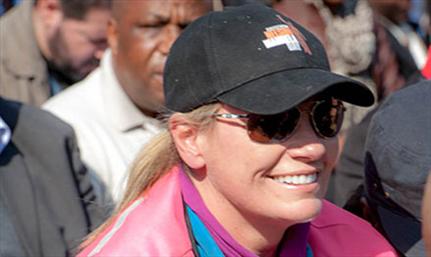|
 |
|
Zelda la Grange
Photo: Sonia Small
19 July 2013 |
Photo gallery
UFS Mandela Day Pledge (pdf)
Zelda la Grange speech (pdf)
The University of the Free State (UFS) joined people around the globe in celebration of the fourth annual Nelson Mandela Day. Long-time Madiba confidant, Zelda la Grange, delivered the main address, inspiring the crowd with anecdotes gleaned from her intimate knowledge of the former president.
La Grange felt that the UFS as an institution can contribute greatly towards the upliftment of South African society.
“Your university has become what we hope for in South Africa – a transformed society whose purpose serves the greater good of humanity. Embrace and nurture what you have here under the leadership of Prof Jansen and his team. And influence society consciously, every day, in the same way as Madiba did for every day of the 67 years of his activism, and beyond.”
As UFS Vice-Chancellor and Rector, Prof Jonathan Jansen, aptly put it, the Kovsie celebrations aim to give thanks to Madiba as a ‘model of humanity’ and for what he has done for all South Africans.
Prof Jansen stressed that the importance of Mandela Day cannot be overstated.
"I think it is incredibly important because the real legacy of Nelson Mandela is that of a man who gave everything he had for the struggle to gain our freedom, our democracy and that we can get along as just human beings and not as a skin colour, a religion or as strangers," he said.
Events began with a clean-up operation by UFS volunteers, Zelda la Grange and the Bikers for Mandela Day, the Mangaung Metropolitan Municipality and other sponsors. The team cleaned areas in Heidedal and Manguang before returning to the UFS Bloemfontein Campus.
Kicking off the campus section of the programme, UFS staff and students formed a ‘human chain’ on the Red Square as part of a wider initiative which was the brainchild of Archbishop Emeritus Desmond Tutu – who was the main attraction of the 2012 Mandela Day activities at Kovsies.
The assembled ‘chain’ recited the UFS Mandela Day pledge, whilst snaking around the Red Square and the gardens surrounding the Main Building, before offering interfaith prayers to Madiba in honour of the 67 minutes of selflessness epitomised by Nelson Mandela Day.
To conclude the first part of the celebrations, the No Student Hungry campaign’s patrons, Mrs Grace Jansen and Dr Carin Buys, released symbolic doves and joined the chain in the singing of the national anthem.
Rudi Buys, Dean of Student Affairs, said that the symbolic chain showed the UFS community’s aim to “join together as a country and show our commitment to our people” on the special day.
Mangaung Metropolitan Municipality Executive Mayor, Thabo Manyoni, together with Prof Jansen, welcomed UFS staff and students to the main festivities which centred around a coin-laying ceremony in front of the Main Building. All proceeds of the coin laying are to be contributed towards the NSH. More than R83 000 was raised through the coin-laying ceremony and donations, more than double the amount of 2012.
The jubilant crowd was edged on by OFM presenter, Johrné van Huyssteen, who offered to preside as master of ceremonies free of charge as part of his 67 minutes.
Manyoni stressed that Mandela Day is a celebration and should be regarded as a joyous occasion. He said that Madiba’s ability to take action and inspire change, is the foremost aspect of his legacy, one all South Africans should strive to emulate.
“We should all be the champions in the areas where we are. There can never be another Madiba, but we should all aim to be smaller, better Madibas,” he said.
Zelda la Grange emphasised the life-changing influence Madiba has had on her own life, as well as South Africa in general.
“Mandela Day is a call to action for individuals, for people everywhere, to take responsibility for changing the world into a better place, one small step at a time, just as Mr Mandela did. It is a day of service,” she said.
According to her, certain key characteristics are responsible for Madiba’s vast reverence throughout the world, principles everyone should try to emulate. She mentioned his principles, simplicity, honesty, integrity, discipline and respect for other people even when opinions differ, as the foremost of these qualities.
La Grange also stressed that the goodwill shown on Mandela Day should not be limited to one day in a year, but that we should all strive to live each day according to these principles.